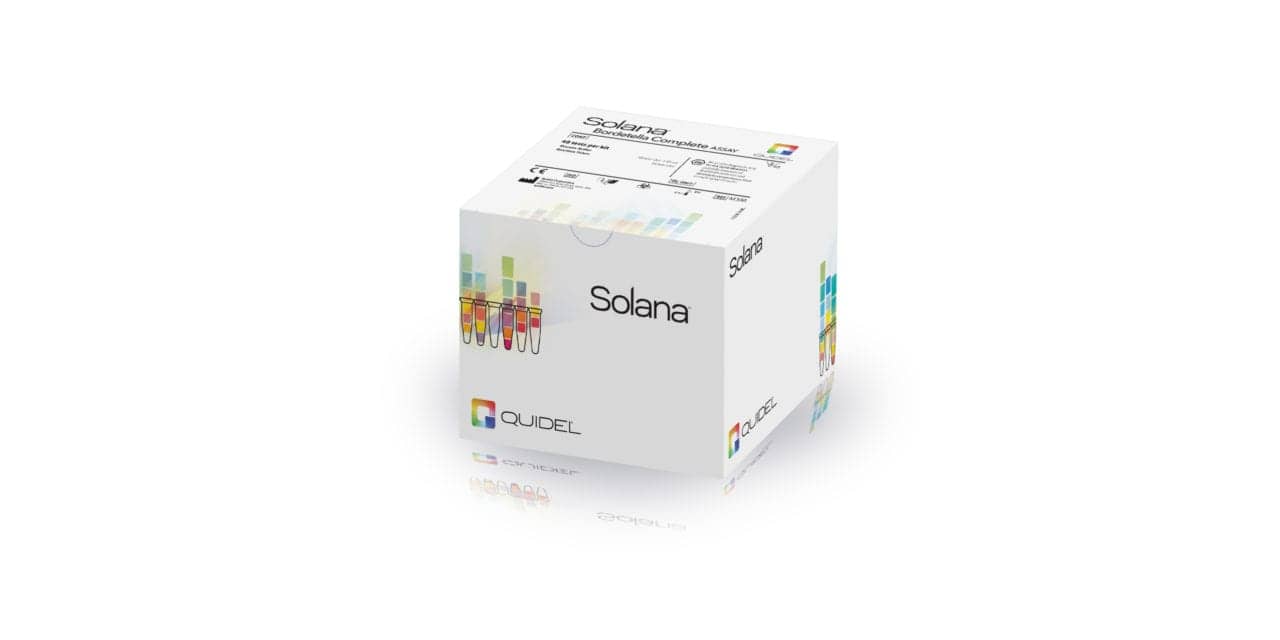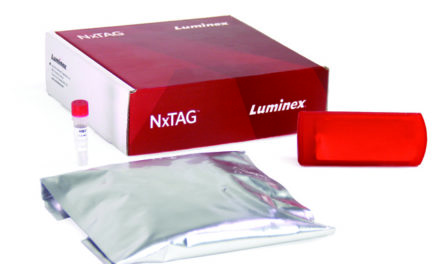In vitro diagnostics manufacturer Quidel Corp, San Diego, has received FDA premarket notification (510(k)) clearance for its Solana Bordetella Complete assay. The product is a molecular diagnostic to be used with the Solana molecular diagnostic instrument for the qualitative detection and differentiation of Bordetella pertussis and B. parapertussis nucleic acids isolated from nasopharyngeal swab specimens obtained from patients suspected of having a respiratory tract infection attributable to these pathogens.
Pertussis, or whooping cough, is a very contagious disease caused by B. pertussis bacteria, which attach to the cilia that line part of the upper respiratory tract, causing inflammation through the release of toxins, in turn causing the airways to swell.1 Pertussis is spread from person to person through the inhalation of bacteria from an infected person’s cough or sneeze. Symptoms, such as a runny nose, low-grade fever, or mild cough usually develop within 5 to 10 days after exposure, but sometimes appear as long as 3 weeks later.
Although whooping cough can cause serious illness in children and adults, it is most dangerous for infants and babies. According to the Centers for Disease Control and Prevention (CDC), about half of infants younger than 1 year of age who get this disease require hospitalization.2
The incidence of pertussis increased significantly during earlier years of this decade, before declining over the past few years.3 Factors that have likely contributed to the increased incidence of pertussis include a decline in vaccine use, waning vaccine-induced immunity in adolescent and adult populations, failure to receive booster shots later in life, and continued circulation of B. pertussis in the population.4,5
According to CDC, B. parapertussis causes a pertussis-like illness that is generally milder than pertussis, likely because the bacteria do not produce pertussis toxin. Coinfection of B. pertussis and B. parapertussis can occur but is uncommon.6 B. parapertussis infection is not easily distinguished from B. pertussis infection by its symptoms and, unlike B. pertussis, it is not usually confirmed by laboratory testing. For these reasons, the epidemiology of illness caused by B. parapertussis is poorly recognized.7
The Solana Bordetella Complete assay leverages the helicase-dependent amplification technology resident in Quidel’s AmpliVue molecular product line to generate a fast and accurate test result on the Solana molecular diagnostic instrument. The assay targets the IS481 and IS1001 sequences of the B. pertussis and B. parapertussis genomes, respectively.
The Solana molecular diagnostic instrument can process up to 12 patient samples in each batched run, and provides timesaving workflow advantages to healthcare professionals in moderate complexity settings. Solana also comes connected to Virena, Quidel’s data management system, which provides aggregated, deidentified testing data in near real-time.
“We are pleased to receive 510(k) clearance for our Solana Bordetella Complete assay, as this test rounds out our Solana molecular test offering in the respiratory category,” says Douglas Bryant, president and chief executive officer of Quidel Corp. “Although whooping cough cases can be sporadic, outbreaks are often highly contagious, and we believe that this test can provide healthcare workers with the ability to quickly diagnose whooping cough and B. parapertussis. When paired with Quidel’s Virena ecosystem, clinicians will be able to see real-time positive cases at the local level, giving them further insights into disease prevalence for both parapertussis and pertussis.”
The Solana instrumented system offers a comprehensive set of 510(k)-cleared assays that enable laboratories to quickly process multiple patient samples to diagnose such infectious disease pathogens as Clostridium difficile, herpes simplex virus 1and 2, human metapneumovirus, influenza A and B, respiratory syncytial virus, strep complete (groups A and C/G), strep group B, trichomonas, and varicella zoster virus.
The commercial introduction of Solana has broadened Quidel’s molecular strategy to include instrumented systems, and grown the number of its molecular platforms that are both 510(k) cleared and available commercially. Quidel’s other FDA-cleared molecular solutions include the AmpliVue noninstrumented system for lower-volume moderate complexity labs, and Lyra reagents for higher throughput, high complexity laboratories that are compatible with existing PCR infrastructure.
References
- Pertusis (whooping cough) causes and transmission [online]. Atlanta: Centers for Disease Control and Prevention, 2017. Available at: www.cdc.gov/pertussis/about/causes-transmission.html. Accessed August 13, 2018.
- Pertussis (whooping cough) signs and symptoms [online]. Atlanta: Centers for Disease Control and Prevention, 2017. Available at: www.cdc.gov/pertussis/about/signs-symptoms.html. Accessed August 13, 2018.
- 2012 final pertussis surveillance report [online]. Atlanta: Centers for Disease Control and Prevention, 2013. Available at: http://www.cdc.gov/pertussis/downloads/pertuss-surv-report-2012.pdf. Accessed August 13, 2018.
- Versteegh FGA, Schellekens JFP, Fleer A, Roord JJ. Pertussis: a concise historical review including diagnosis, incidence, clinical manifestations, and the role of treatment and vaccination in management. Rev Med Microbiol. 2005;16(3):79–89; doi: 10.1097/01.revmedmi.0000175933.85861.4e.
- Atwell JE, Van Otterloo J, Zipprich J, et al. Nonmedical vaccine exemptions and pertussis in California, 2010. Pediatrics. 2013;132(4):624–630; doi: 10.1542/peds.2013-0878.
- Faulkner A, Skoff T, Cassiday P, Tondella ML, Liang J. Manual for the Surveillance of Vaccine-Preventable Diseases, Chap. 10: Pertussis [online]. Atlanta: Centers for Disease Control and Prevention, 2017. Available at: www.cdc.gov/vaccines/pubs/surv-manual/chpt10-pertussis.html. Accessed August 13, 2018.
- Mastrantonio P, Stefanelli P, Giuliano M, et al. Bordetella parapertussis infection in children: epidemiology, clinical symptoms, and molecular characteristics of isolates. J Clin Microbiol. 1998;36(4):999–1002.






